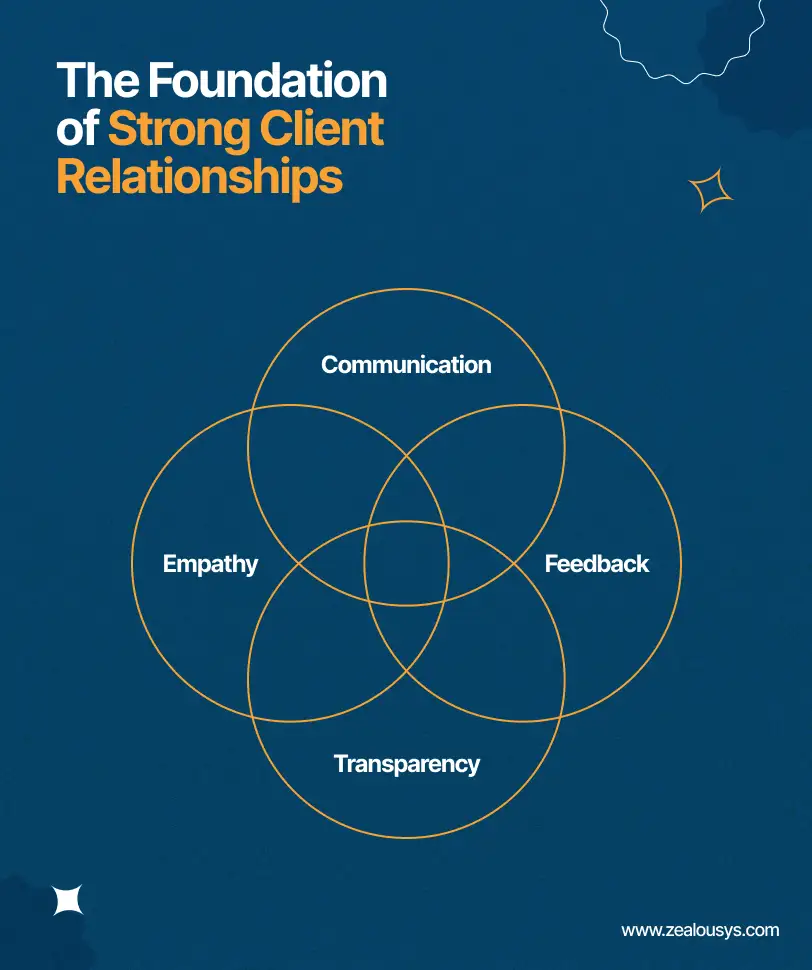
We use cookies and similar technologies that are necessary to operate the website. Additional cookies are used to perform analysis of website usage. please read our Privacy Policy
Building Lasting Client Relationships: A Director’s Perspective

Client. It’s a word that defines everything we do. Every project, every interaction, and every goal we strive for as a company revolves around this one word. We all remember the early days when we first brought on that client who believed in our vision. It was more than just business; it was the beginning of a partnership.
Over the years, we’ve learned that building lasting client relationships isn’t just about delivering results; it’s about understanding, trust, and genuine care for their needs. In this blog, our Director, Pranjal Mehta, shares insights into how we’ve approached client relationships, the strategies that have worked for us, and the challenges we’ve faced along the way. It’s not always easy, but it’s always worth it.
The Foundation of Strong Client Relationships

Strong client relationships are built on good communication, understanding, honesty, and always delivering value. Communication is key to making sure everyone’s on the same page with expectations and goals. Being open and honest builds trust and helps solve problems quickly.
Understanding a client’s challenges and showing you care about their success makes them feel valued and loyal. Being clear about what you can do and what challenges might come up is important too—clients appreciate that honesty.
And of course, always giving value—whether it’s through great work, helpful advice, or just going above and beyond—helps build trust. Asking for feedback shows clients their opinions matter and helps you improve.
When all of this is in place, it creates strong partnerships that lead to repeat business and positive referrals.
Strategies to Build and Strengthen Relationships

1. Communicate Clearly and Consistently
You know, back in my earlier days, I learned the hard way how important clear communication is. I remember one client who was really particular about staying updated. At first, I thought a quick email every couple of weeks would be fine, but that didn’t sit well with them.
They wanted more frequent updates, and that’s when I realized communication isn’t just about checking off a task; it’s about making sure your client feels informed every step of the way. So now, I make it a point to keep the lines open and update clients regularly. It builds trust and helps avoid any surprises later.
2. Be Confident and Positive in Every Interaction
There was this one project I worked on where everything went wrong. The deadlines were tight, and we had a few setbacks. I could feel the pressure mounting, but I knew I had to stay calm and positive for my client. I remember sitting down with them, taking a deep breath, and confidently saying,
“We’ve got this. Here’s the plan to get us back on track.” And you know what? That confidence really rubbed off on them. They felt reassured, and we ended up delivering on time. Clients look to you for confidence, especially when things aren’t going perfectly, so always try to stay positive and lead with confidence.
3. Treat Clients Like People, Not Just Projects
It’s important to remember that clients are more than just transactions. Taking the time to acknowledge their personal interests or milestones can make a real difference. Small gestures, like asking about their family or sharing something relevant they might like, can help make your relationship feel more genuine and personal.
4. Help Clients Understand Your Process
Not all clients will be familiar with your work or how things unfold. Take a moment to explain your approach and the reasoning behind it. When clients understand the process, it builds their confidence in your expertise and keeps them engaged in the project.
5. Exceed Expectations with Your Results
I’ve always believed that delivering exceptional results is the key to long-term client relationships. But there was one project where I made sure not just to meet expectations, but to exceed them. I knew the client was struggling with a few areas, so I went the extra mile, offering a few bonus services at no extra cost.
At the end of the project, they were so impressed that they asked me to handle several more projects for them. It wasn’t about promising the world; it was about doing more than expected and showing them how much I cared about their success. Going that extra mile not only impressed them but also turned them into a loyal client.
So, yeah, from personal experience, building strong client relationships takes effort, but it’s the small things the communication, the confidence, the personal touch that really make a lasting impact. Just remember, clients appreciate the genuine care and effort you put in. That’s what keeps them coming back.
How Leadership Shapes Client Relationships?
Leadership really shapes client relationships by setting the stage for trust, clear communication, and teamwork. When leaders focus on putting the customer first, it helps everyone in the company keep clients’ needs top of mind, which leads to more satisfaction and loyalty. Taking the time to listen to clients and understand their challenges makes it easier to align the team’s efforts with what the client actually needs.
A good leader also encourages open communication, which helps solve problems quickly and builds a real partnership between the business and the client. This approach not only makes the client experience better but also boosts team morale, since everyone feels heard and involved.
When leadership gets this right, it turns simple transactions into long-lasting partnerships. By focusing on trust, communication, and collaboration, leaders can create a positive reputation that keeps clients around and draws in new ones.
Challenges in Client Relationship Management
Managing client relationships can be incredibly rewarding, but it definitely comes with its fair share of challenges. From aligning expectations to handling unexpected issues, the process of nurturing these relationships can sometimes feel like navigating a maze. Based on my own experiences, here are some of the most common challenges I’ve faced—and a few tips on how to overcome them.
1. When Expectations Don’t Match Up
One of the biggest hurdles in client relationships is when expectations aren’t clear from the start. Early on in my career, I remember a project where the client had a different idea of success than we did. It led to frustration on both sides, and the project’s progress suffered.
The key here is setting clear, upfront expectations and keeping that communication open throughout the project. You need to be crystal clear on deliverables, timelines, and outcomes so there’s no confusion down the line.
2. What Happens When Communication Goes Silent
Sometimes, clients aren’t the best at staying in touch, and it can make the whole relationship feel disconnected. I’ve been in situations where the client’s lack of communication delayed projects, and we were left guessing about their needs.
In these moments, it’s important for us as leaders to take the initiative. Regular check-ins, whether it’s through emails, meetings, or calls, can help ensure that communication stays on track and that everyone is aligned.
3. When Clients Ask for the Moon (and You Have to Say No)
We’ve all had clients who ask for the impossible—tight deadlines, last-minute changes, or features outside of the scope. Early on, I learned that saying “no” can be one of the hardest things to do but also one of the most necessary.
As leaders, we need to manage those expectations and be honest about what’s possible. If something is out of scope or unrealistic, it’s best to discuss it openly and offer alternatives that are more feasible.
4. Juggling Competing Priorities (and Keeping Everyone Happy)
Clients often have competing priorities, and sometimes they’re juggling multiple projects at once. This can make it hard for them to prioritize your project and can lead to delays. I remember working with a client who kept shifting priorities, and it affected our timeline.
To tackle this, I’ve found that it’s crucial to stay organized, set clear milestones, and regularly review the project’s progress together to keep everyone on the same page.
5. The Tough Conversation
No matter how much you strive to do your best, there will be times when clients aren’t happy with the work. Negative feedback can be tough to hear, but it’s essential to approach it with a growth mindset.
I’ve had my share of tough conversations, but what helped me was listening intently, acknowledging the feedback, and showing that I genuinely care about improving the situation. Turning a dissatisfied client into a satisfied one often comes down to how well you handle those moments.
In conclusion,
Building and keeping strong client relationships is key to long-term success. It takes good communication, understanding, honesty, and always doing your best to meet or exceed expectations. While there are challenges, like making sure everyone is on the same page, handling tough feedback, or keeping track of changing priorities, dealing with them with care and honesty can turn problems into chances to grow.
Leadership is crucial in shaping these relationships. When leaders put clients first and support their teams in doing the same, it creates a positive atmosphere that strengthens the whole company.
At the end of the day, it’s not just about finishing projects; it’s about developing lasting partnerships where everyone feels valued. The effort put into building these relationships leads to repeat business, good referrals, and a solid reputation that attracts new opportunities. With the right approach, client relationships can drive success for everyone.
We are here
Our team is always eager to know what you are looking for. Drop them a Hi!
Zealous Team
Meet the Zealous Team – your dedicated source for cutting-edge insights on the latest technologies, digital transformation, and industry trends. With a passion for innovation and a commitment to delivering unparalleled expertise.
Table of Contents
×


Comments